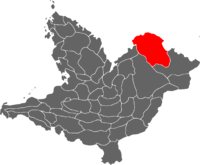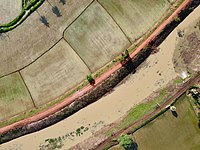Yajawil of Xukaj
Yajawil of Xukaj | |
|---|---|
| Motto: United Voices | |
| Anthem: Hymn for the Communion | |
 Location of Xukaj in the Mutul | |
| Capital and | Puylum |
| Official languages | Mutli |
| Recognised national languages | |
| Ethnic groups (2020) | |
| Demonym(s) | Xukajeses |
| Government | Absolute monarchy |
| Legislature | Chika Holpop |
| Chika Sajal Ch'ob | |
| Chika Mam Ch'ob | |
| Province of the Mutul | |
| Area | |
• | 138,512 km2 (53,480 sq mi) (2nd) |
The Yajawil of Xukaj is one of the two southernmost provinces of the Mutul. Centered around the lower beds of the Kuwajuwa and Chetzaj rivers, its capital Puylum is located at the mouth of the former on the Kayamuca Sea' coast. It shares a land border with the kingdom of Orun Redisus to the east as well as with the other Mutuleses provinces of Nolkaj to the south-east, Yajumel to the south-west, and Jalchi to the west. It is the second largest Viceroyalty of the Mutul, right behind its neighbor Yarumel (162,016 km²).
The original inhabitants of the Province were speakers of various Chibchan languages of which Dule and U'wa peoples are modern representatives. The region is known as an important agricultural and industrial center for the Divine Kingdom with strong commercial relations with its neighbor, other countries in the Kayamuca Sea, and Sante Reze.
It is a very ethnically diverse region where the dominant Ch'olti culture only arrived during the 14th century and wouldn't become the norm until the 1800s. This leave the region as home to different White Path denomination and temples, many of which find their roots in the antique Chibchas religious practices which put the emphasis on the Voice, generally through religious songs and oral traditions.
Etymology
Geography
The region features two of the longest rivers in the Mutul, the Kuwajuwa and Chetzaj rivers, on the shores of which humans have settled since prehistoric times. The natural vegetation of the region has for the most part dissapeared and survive mostly in the more mountaineous area. In the rest of the country, the dominant form of agriculture allowed by irrigation canals fed by water from the two rivers has heavily altered the environment of the province.
Climate
Most of the Viceroyalty has a Tropical monsoon climate, a tropical climate with a short dry season and heavy rainfall for the majority of the year. In the Köppen climate classification, it is classified under the letters Am. Tropical rainforest is the natural vegetation, and also provides the other climate type located in the state.
History
Politics
Economy
Agriculture
Xukaj is rich in water, with its two major rivers feeding many rivers, reservoirs, and wetlands, but poor in quality soils. As a result, most of the production is done through a system of Raised fields. Beside producing electricity and securing access to freshwater for the region, the artificial lakes created by Hydroelectric dams are also the reservoirs feeding a complex system of canals used both for the transport of goods and for the irrigation of the Raised Fields. Those canals are also used since pre-classic times for pisciculture where the Eutrophication of the water is avoided by using the fish wastes, muds, and other sediments accumulating within the canals as fertilizer for the fields.
Raised fields are privately owned and exploited intensively and industrialy with one field corresponding to one agricultural product (although which one may vary from year to year). Xukaj is a net exporters of products such as Maize, cotton, tobacco, sugar cane, and pineapple. Fish farms also produce cichlids but also introduced species such as shrimps, Grass carps, and so on.
The Xukaj face many challenges due to its model of production, including the threat of Pesticides and chemical Fertilizers on water quality, human health, and fishing. Population growth has also led to a reduction in farmlands, the raised fields being instead "fortified" with concrete and used as foundation for new urban agglomerations, a movement accompanied with the growth of the road network of the region which further aggravate the problem soil artificialisation and place threats not only on food production and human health, but also on the populations' resilience to natural disasters such as hurricanes or floods.
Energy production

Mut-Ek'taha, the state-owned oil company of the Mutul, is present in Xukaj where it is involved in various operation. It has financed multiple Biofuel production ventures in the Viceroyalties, investing in research and development of Biogasoline, Algae fuel, Ethanol fuel and other "alternative" sources of gasoline. After the discovery of off-shore oil reserves in the neighboring Orun Redisus' national waters, Mut-Ek'taha had begun its own program of exploration in the area, with little success. Most of the oil produced by the Mutul is still extracted from the Gulf of Ochk'ak'n'ab, on the other side of the country.
Hydroelectricity is the main source of energy for the Viceroyalty, overing around sixty percents, which is around the Mutul' national average but less than its southern neighbor of Nohkaj (81%). Electric production is done both by run-of-the-river and Reservoirs dams. Another 10 percents of the electric production come from solar farms and another 10% from Biomass and agricultural residues. As a result, Xukaj is almost autonomous, energy-wise, from the rest of the Mutul importing only 20% of its electricity needs in the form of oil products, coal, and natural gaz from the rest of the country (15%) and the rest from miscellaneous import from Orun Redisus and other countries.
Manufacturing
The traditional main industry of Xukaj is the Textile industry, notably with the production of Mola clothes, a textile specific to the Viceroyalty and associated mainly with the Dule. The region is also a producer of natural and chemical dyes, cotton (from Cultivation to Weaving and Finishing), and artificial fibers. It is the second largest employment generating sector in Xukaj, behind agriculture. The Dule and Ch'olti merchant-nobility of the region was the first part of the Mutulese' Elite to have truly embraced the industrial revolution, with the first Cotton mill opening in the region at the beginning of the 19th century, even before the Sajal War and the Itzamnaaj Reforms of the 1840s.
The other major industries of Xukaj include shipbuilding, Pharmaceutical industry, electronics, and leather goods manufacturing. A significant part of the Viceroyalty' economy is aimed at providing manufactured goods to the neighboring countries of Orun Redisus and Sante Reze, with enterprises from these countries delocalising their factories to the Mutul to take profit from the cheaper production costs. Both Pantra A.E and Aldmerta Automotive, the main automotive producers of Orun Redisus, have the majority of their assembly plants in Xukaj.
Demography
Culture
Religion
Xukaj is home to a wide variety of White Path denominations or sects. These are generally the survivance of pre-Mutul cults or religions, and show different level of integration to the larger White Path corpus of practices and texts. The most famous of these denomination is Karekaism, the sect of the U'wa people. Named after their religious figures (the Karekas), this odd denomination of the White Path put the emphasis on purity. They use the ritual calendar to determine the most auspicious dates for purifications ceremonies which include bathing, sweatlodges, confessions, and bloodletting. They notably consider any non-U'wa person, even other White Pilgrim, to be "impure" and food prepared by them to be "unclean". While adoptions and convertion to Karekaism are not impossible, they are especially difficult and framed as purification ceremonies as well.
Singing play an especially important role in Karekaism. All Karekas will meet once-a-year, with as many U'wa pilgrims as possible alongside them, at the foot of Mount Achekwa, their holiest site. There, they are to "sing the world into being" so as to maintain the balance between the five layers of the physical world (earth, water, oil, mountains, and sky) and the three layers of the universe (13 Heavens, 5 Earths, 9 Underworlds). There is thus an extensive and original musical tradition that emerged from the U'wa and they represent one of the most original communities of the Mutul.
The Onmaked Nega is another religious sect native to Xukaj. It is an Order of priests known as Saila who often serve as both the religious leaders and Batabob of the Dule people. The Dule' Kuchkabal is thus a very special affair as it is presided by the Onmaked Nega, the "Congress", which gather once a year in a large-scale religious festival during which the Saila priests will sing songs to the pilgrims and expose the history of the Dule, while also conducting political activities such as the presentation by the Halak Winik of the bilan of his Cabinet and the election of a new Halak Winik by the Congress.
Another important aspect of Xukaj' religious life is the School of Masirgutia, a cult especially popular among the Ette Ennaka in the south of the region. They follow the teachings and lessons of Masirguta, an immortal that was occulted from the mortal and an avatar of Itzamna which they call Narayajana or Yao. The Nawi of Puylum is handled by priests of Masirgutia and Narayajana, with their own canon texts and commentaries of the Bitzk'uh. The Awapa Sibu is another popular cult native to the region. Its priests, or Awapa, are from specific lineages of Bribri clans who pass down their knowledge from the uncle to the nephews. They are considered a school of Aj Menob, or traditional doctors, by the religious authorities with a specific method of healing based on special songs and hymns to connect to the spirits of the plant, the disease and the patient. Once this connection is established the awa converses with all these spirits until the identity of all three are revealed and the medication (the plant) given. The Awapa Order is famous for using Pagodas instead of pyramids as their main religious monuments. Bribri pagodas can be three, four, or thirteen floors high and are always supported by eight pillars.
Finally, Xukaj was also the birthplace of the youngest oracular brotherhood in the Mutul: the Brotherhood of Chilan Chi or "Mother Besikö". Established in the 1970s around the figure of Besikö, a Ngäbe woman, who had visions of Ix Chel and Itzamna and began preaching their new message which included the Abolition of alcohol, of fences and private property, disengagement from market society, and strict non-violence including adopting a vegetarian diet. Members of the Brotherhood thus isolate themselves in the mountain west of Xukaj and practice contemplation and meditation while living a communal lifestyle.



